Retrieval Augmented Generation with Knowledge Graphs
Reference: Edge, D., Trinh, H., Cheng, N., Bradley, J., Chao, A., Mody, A., ... & Larson, J.. . arXiv:2404.16130
Written by Jeremi Levesque. https://arxiv.org/abs/2404.16130
Table of Contents
Quick Summary
- GraphRAG is RAG where the retrieval path utilizes a knowledge graph.
- It improves the comprehensiveness and diversity of answers compared to RAG and it also enables questions/answers on more general and underlying themes of the data.
- Building the knowledge graph is the more complicated task than actually using GraphRAG.
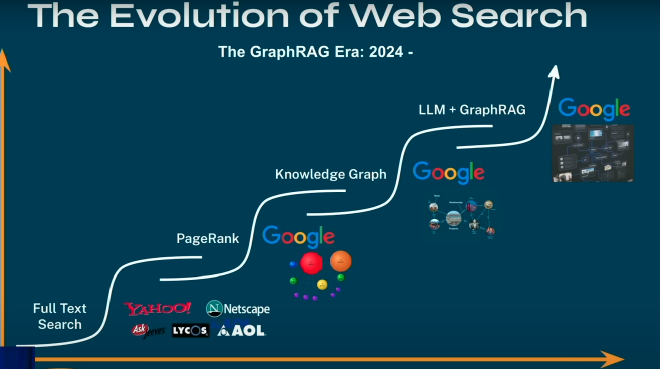
Graph RAG 2 #
Context #
At the time of writing, knowledge graphs have been powering search across the web for around 12 years since Google announced in 2012 that the search experience would be enhanced by it. Knowledge graphs were meant to improve understanding of queries (especially some ambiguous queries) and to provide the user with a quick high-level summary of the things the user was possibly looking for. Also, it can be used to feed the user with possible new information that is linked in some way with the information on the subject he was searching for.
In the context of LLMs, naïve retrieval augmented generation (RAG) could be, roughly, the equivalent of Google before 2012 when no knowledge graph was involved. That would mean matching the user’s query to the most relevant websites or the most similar documents in the knowledge base in the context of RAG. Of course, we over-simplify greatly for the purpose of the explanation, but the main idea of GraphRAG is to enhance the retrieval part of RAG by improving it the same way Google improved its search engine: using knowledge graphs to also provide some relevant and higher-level summaries of the information in the knowledge base corresponding to the user’s query.
This way, GraphRAG can enable the LLM to capture global information about a corpus of text such as a general theme of a dataset. In some retrieval-focused tasks, the LLM can be empowered by looking through its knowledge base using similarity comparisons since it only needs to find information that’s explicitly written somewhere in it’s knowledge base. However, some tasks require an understanding of the relationships of different parts of the knowledge base. For example, “What are the main themes in the dataset?” would be a query-focused summarization (QFS) task which would require the understanding of the relations between words of that dataset as the theme is often not explicitly written in a document.
The main idea is described as follows:
- Derive an entity knowledge graph from the source documents.
- Pre-generate community summaries for all groups of closely-related entities.
- When the system receives a question: each community summary is used to generate a partial response.
- Summarize all the partial responses from each community into a final response to the user.
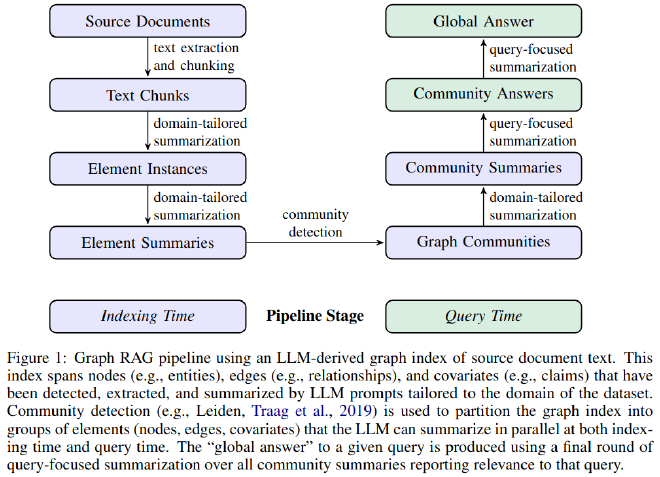
Method #
As most RAG methods3, this method starts with a stage of indexing which basically consists of organizing the knowledge base (in advance, before deploying the system) in a knowledge graph. The second stage of that method is what’s executed once the system receives a query from the user. That process is separated in two different workflows that are detailed below.
Indexing (precalculated) #
- Source Documents -> Text Chunks
- As in naive RAG, we separate each document in different chunks. The smaller the chunks, the more detailed information about the documents we save, but with a higher number of nodes in our graph (or database in the case of naive RAG).
- Text Chunks -> Element Instances -> Element summaries
- Extract entities (persons, places, objects, etc.), relationships and key claims (facts, affirmations) of each chunk.
- Ask the LLM using multiple gleaning (extraction) rounds to identify instances until it has affirmed that not many other instances could be identified.
- Output: subgraph-per-chunk containing a list of entities (name, type, description) and a list of relationships (source, target, description).
- Remove duplicates in each list by merging their attributes/descriptions.
- Summarize entity, relationships and claims.
- Ask the LLM for a short summary that captures all the distinct information from the description of each entity/relationship to have a single concise description of them.
- Extract entities (persons, places, objects, etc.), relationships and key claims (facts, affirmations) of each chunk.
- Augment the graph
- Community detection
- Perform hierarchical clustering on the initial knowledge graph using Leiden technique to identify communities. This applies a recursive community-clustering to the graph until a community-size threshold has been reached.
- Multiple levels and hierarchy of communities will be identified providing a structured way to navigate through the graph.
- Graph Embedding
- Transform the graph into a vector representation. Using the Node2Vec algorithm, each node is represented as a vector in a lower-dimensional space where adjacent nodes in the graph are represented by vectors close to each other.
- Useful vector-space in which to search for during the query phase.
- Community detection
- Community summarization
- Generate Community Reports
- Ask the LLM to generate a summary of each community (at all levels of the hierarchy identified in step 3.1) to provide the knowledge base with a scoped understanding of the graph at different granularity.
- Summarize Community Reports
- Ask the LLM to summarize each report of the communities for shorthand use.
- Community Embedding
- Generate a vector representation of the communities by generating text embeddings of: the community report + report summary + title.
- Useful vector-space in which to search for during the query phase.
- Generate Community Reports
Querying (at runtime) #
Two types of workflows are proposed to answer different queries. Those two types of workflows relate directly to retrieval-focused and query-focused summarization tasks that was mentioned above. To answer retrieval-focused tasks, which are questions that require an understanding of specific entities that are mentioned in the documents, the local search workflow would be the pipeline that would enhance an answer to such a question which is what most RAG pipeline aim to do. On the other hand, to answer questions that require a more general understanding of the knowledge base (e.g. the theme), the global search is meant to help with that, which was the core idea behind the paper.
Local search #
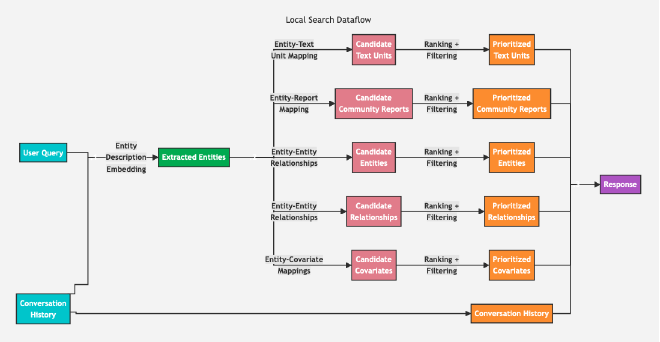
This local search method identifies a set of entities from the knowledge graph that are semantically-related to the user’s query (also considering the conversation history). Those entities serve as access point into the knowledge graph to extract other information such as neighbouring entities, relationships, claims, community reports (of any level) and relevant raw text chunks that are associated with those entities. All of these candidate source of information are ranked and filtered to fit within a window of pre-defined maximum number of tokens, including only the most relevant information to be used to generate an answer to the user.
Global search #
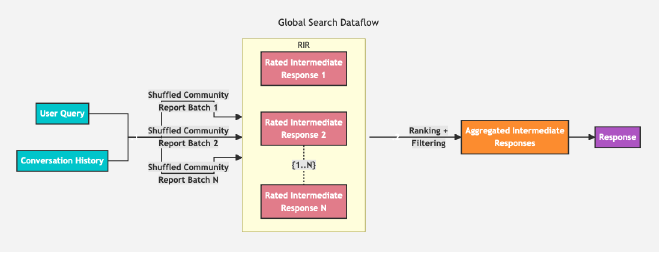
This global search approach is the most well-suited workflow to handle tasks that require a broader understanding of the knowledge graph. The community summaries generated during the indexing pipeline are here used to general an answer in a multi-stage process. This workflow utilizes a map-reduce approach:
- Prepare community summaries.
- Randomly shuffle and divide the community summaries into several pre-defined chunk sizes. We want the information of the community summaries to be distributed across the different chunks (called “Shuffle Community Report Batch N” in the image).
- Map community answers.
- For each chunk, generate an intermediate answer in parallel based on its respective shuffled community report chunk.
- Also, ask the LLM to evaluate how helpful the generated answer is in answering the target question on a value between 0 and 100. Answers with score=0 are filtered out.
- Reduce to global answer.
- Sort the intermediate answers in descending order from most to least useful based on the score given by the LLM in the previous step.
- Add all the most useful intermediate answers that fit in the context window that will then be used to generate the global answer to the user.
Benchmark #
Datasets:
- Compiled podcast transcripts from Behind the Tech, by Kevin Scott. ~1M tokens.
- New articles published from September 2013 to December 2023 in a range of categories (entertainment, business, sports, tech, health and science). ~1.7M tokens.
Global questions
Since the paper primarily focuses on the global search, the objective was to evaluate the effectiveness of RAG systems for more global sensemaking tasks. They asked the LLM to generate N questions that require the understanding of the entire corpus.
Conditions (four levels of graph communities to compare) #
C0: Using root-level community summaries (fewest in numbers).
C1: Using high-level community summaries. Sub-communities of C0.
C2: Using intermediate-level community summaries. Sub-communities of C1.
C3: Using low-level community summaries (greatest in numbers). Sub-communities of C2.
TS: Source texts (instead of community summaries) are shuffled and chunked for the map-reduce summarization stages.
SS: Naïve RAG.
Results #
- Global approaches consistently out-perform the naïve RAG approach in both comprehensiveness and diversity metrics for a win rate around 72% on average.
- Naïve RAG produces the most direct responses (50-60% win rate for directness) across all comparisons.
- Community summaries generally provided a small but consistent improvement in comprehensiveness and diversity (except for C0).
- Empowerment showing mixed results. Tuning element extraction prompts may help.
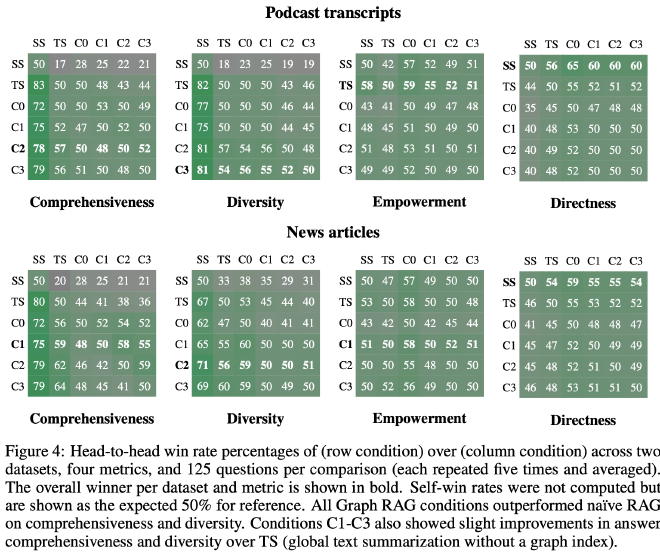
The following Table 3 illustrates the scalability advantages of such a method. Utilizing higher-level community summaries allows to use significantly less tokens than utilizing raw document summarization which utilized the most resources to provide the answer. For low-level community summaries (C3), it required 26-33% fewer tokens while for root-level community summaries (C0) it required 97% fewer tokens!
References #
“GraphRAG: The Marriage of Knowledge Graphs and RAG: Emil Eifrem” viewed on Sept. 16th 2024. https://www.youtube.com/watch?v=knDDGYHnnSI. ↩︎
Edge, D., Trinh, H., Cheng, N., Bradley, J., Chao, A., Mody, A., … & Larson, J. (2024). From local to global: A graph rag approach to query-focused summarization. arXiv preprint arXiv:2404.16130. ↩︎
https://docs.nvidia.com/ai-enterprise/workflows-generative-ai/0.1.0/technical-brief.html ↩︎